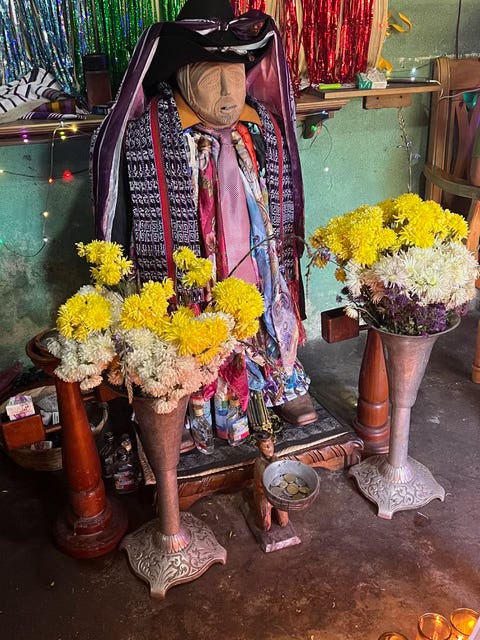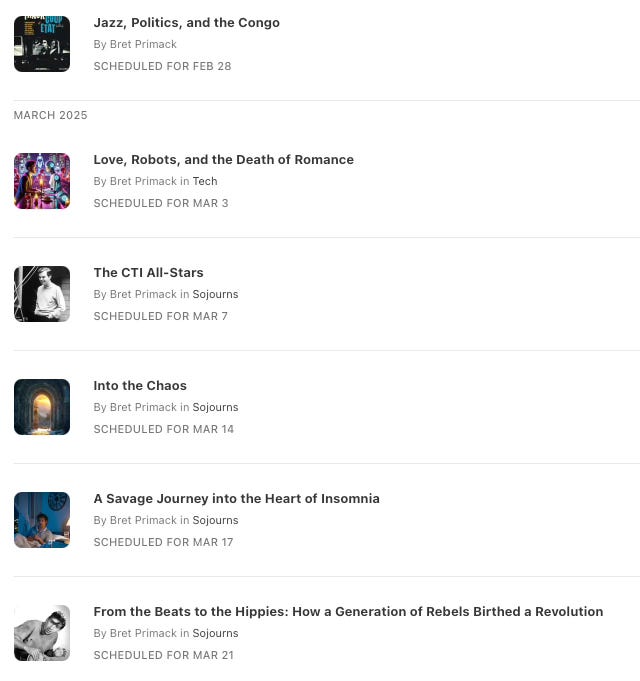Meet Maximón: The Liquor-Drinking, Chain-Smoking Saint
Where Mysticism Meets Vice in Guatemala’s Living Legend
While exploring Guatemala, Sherrie connected with an embroidery artist in Santiago Atitlán, a quaint pueblo nestled on the shores of the stunning Lake Atitlán. She couldn’t resist purchasing one of his vibrant paintings, a piece that seemed to capture the soul of the place. As if that wasn’t enough of an adventure, his sister appeared and offered to guide us through the labyrinth of narrow, winding hallways. At the end of the journey, we found ourselves face-to-face with the enigmatic Maximón.
Maximón is the chain-smoking, liquor-guzzling saint of Guatemala, the man-god who doesn’t play by your Sunday School rules. This guy doesn’t float on clouds or wave a golden halo. Nope, he sits in his shrine, dressed sharp in a suit, sunglasses on, hat tilted just right, with a cigarette dangling from his lips like he’s halfway through a noir flick. He’s the patron saint of keeping it real and playing dirty if you need to.
The Legend of Maximón
Who is this smoky-eyed enigma? Part Mayan deity, part Catholic saint, and all swagger. Maximón, or San Simón if you’re trying to sound proper, rose from the chaotic fusion of Mayan spirituality and Spanish Catholicism—a cosmic cocktail of conquest and resistance. You want to know his origin story? Good luck. He’s tied to pre-Columbian gods of fertility and the underworld, but over centuries, he’s become something else entirely: a spiritual maverick who doesn’t fit neatly into anyone’s box. He’s not holy, but he’s not evil. He’s just Maximón.
The Worship Scene
His followers don’t come looking for eternal salvation or choir-of-angels bliss. They come for results. Protection? Check. Love advice? Sure thing. Help sticking it to your enemies? You bet. The man doesn’t judge; he delivers. His shrines are riotous, electric affairs decked out in scarves, candles, cigars, and enough booze to stock a speakeasy. People kneel, pour him a shot of aguardiente, and light up his smokes like they’re sharing secrets with their favorite bartender.
In Santiago Atitlán, the epicenter of Maximón’s cult, he moves from house to house every year, hosted by a local cofradía (brotherhood). Imagine that—a saint with a travel itinerary. Pilgrims show up to perform wild, smoky rituals involving candles, prayers, and an uncanny blend of reverence and revelry. They whisper requests for wealth, health, revenge, or just the courage to face another damn day. And Maximón, lounging in his makeshift throne, seems to say, “I got you.”
The Wild Card Saint
Maximón isn’t here to win you morality points. He drinks, smokes, and doesn’t care if the church approves. That’s part of his charm. He’s messy, like life itself, and that’s why people love him. While some folks call him blasphemous or outright demonic, his devotees see something deeper: a saint who gets them. Someone who embraces their flaws and fights their battles, vices and all.
He’s not an icon for the faint-hearted, but he’s perfect for those who know life isn’t all halos and harps. He’s the antihero in a world full of pious do-gooders, the spiritual equivalent of a noir detective—gritty, complex, and undeniably magnetic.
Maximón Today: Cult Hero and Tourist Magnet
In modern Guatemala, Maximón is a cultural rockstar. Locals and travelers alike are drawn to his legend. Tourists snap photos, half in awe and half in disbelief, while the faithful light candles and pour shots at his feet. Maximón thrives in this tension, a living symbol of Guatemala’s resilience and rebellious spirit.
This guy isn’t just a saint; he’s a statement. He’s the embodiment of survival, a reminder that faith doesn’t always come clean-shaven and buttoned-up. Sometimes it’s raw, wild, and unapologetically human.
So, next time you’re in Guatemala, grab a Tuk-Tuk, find the nearest Maximón shrine, and raise a glass in his honor. He’ll be waiting, cigarette in hand, with a sly grin that says, “Let’s talk business.”
The energy in that cramped little apartment where Maximón currently resides was electric—thick, palpable, and utterly unlike anything I’ve felt before. We spent maybe twenty minutes in that room, though it might as well have been an eternity for the impression it left on me. This wasn’t just a tourist stop; it was one of those rare, soul-rattling experiences that lodges itself deep in your memory, refusing to fade.
I wouldn’t call myself a religious man—faith and doctrine have never quite been my thing—but I’m a spiritual fellow through and through. And let me tell you, there were spirits in that room. Not the kind you find in bottles (though Maximón wouldn’t mind those either) but something raw, ancient, and undeniably alive. Whatever you want to call it—energy, presence, power—it was there, and it was real. Maximón’s gaze, carved and painted though it was, seemed to pierce through the layers of who I thought I was, leaving me with the unmistakable sense that I was in the company of something far greater than myself.
Here’s a short video about Maximón produced by National Geographic:
Coming soon to your screen:
As always, let your conscience be your guide.







A relative of Santa Muerte.